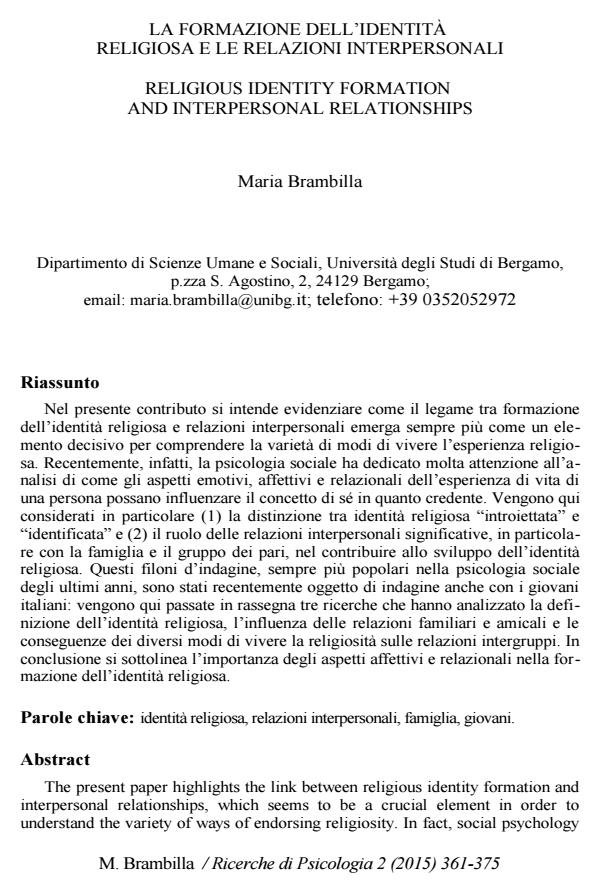La formazione dell’identita religiosa e le relazioni interpersonali
Titolo Rivista RICERCHE DI PSICOLOGIA
Autori/Curatori Maria Brambilla
Anno di pubblicazione 2015 Fascicolo 2015/2
Lingua Italiano Numero pagine 15 P. 361-375 Dimensione file 229 KB
DOI 10.3280/RIP2015-002006
Il DOI è il codice a barre della proprietà intellettuale: per saperne di più
clicca qui
Qui sotto puoi vedere in anteprima la prima pagina di questo articolo.
Se questo articolo ti interessa, lo puoi acquistare (e scaricare in formato pdf) seguendo le facili indicazioni per acquistare il download credit. Acquista Download Credits per scaricare questo Articolo in formato PDF

FrancoAngeli è membro della Publishers International Linking Association, Inc (PILA)associazione indipendente e non profit per facilitare (attraverso i servizi tecnologici implementati da CrossRef.org) l’accesso degli studiosi ai contenuti digitali nelle pubblicazioni professionali e scientifiche
Nel presente contributo si intende evidenziare come il legame tra formazione dell’identita religiosa e relazioni interpersonali emerga sempre piu come un elemento decisivo per comprendere la varieta di modi di vivere l’esperienza religiosa. Recentemente, infatti, la psicologia sociale ha dedicato molta attenzione all’analisi di come gli aspetti emotivi, affettivi e relazionali dell’esperienza di vita di una persona possano influenzare il concetto di se in quanto credente. Vengono qui considerati in particolare (1) la distinzione tra identita religiosa "introiettata" e "identificata" e (2) il ruolo delle relazioni interpersonali significative, in particolare con la famiglia e il gruppo dei pari, nel contribuire allo sviluppo dell’identita religiosa. Questi filoni d’indagine, sempre piu popolari nella psicologia sociale degli ultimi anni, sono stati recentemente oggetto di indagine anche con i giovani italiani: vengono qui passate in rassegna tre ricerche che hanno analizzato la definizione dell’identita religiosa, l’influenza delle relazioni familiari e amicali e le conseguenze dei diversi modi di vivere la religiosita sulle relazioni intergruppi. In conclusione si sottolinea l’importanza degli aspetti affettivi e relazionali nella formazione dell’identita religiosa.
Parole chiave:Identita religiosa, relazioni interpersonali, famiglia, giovani
Maria Brambilla, La formazione dell’identita religiosa e le relazioni interpersonali in "RICERCHE DI PSICOLOGIA " 2/2015, pp 361-375, DOI: 10.3280/RIP2015-002006